IT specialist on vacation: what about the telescope?
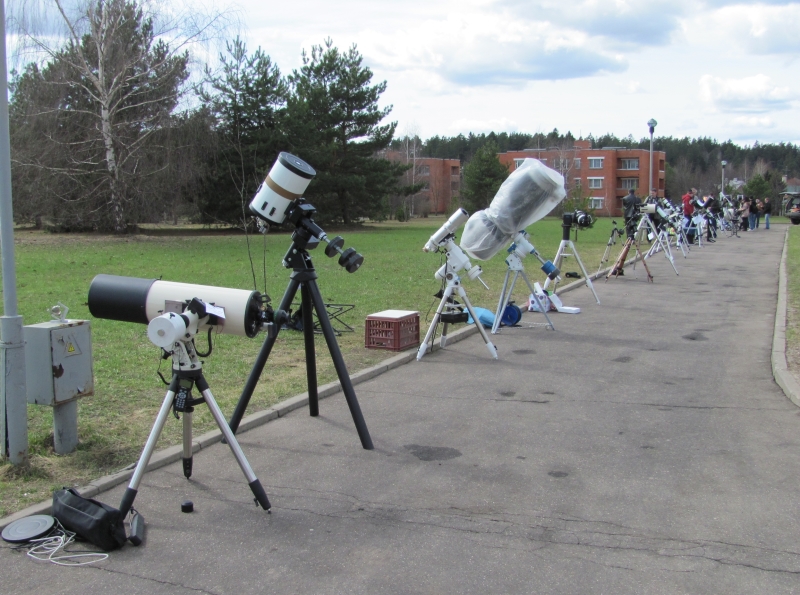
You read a post about what to observe in the sky , looked yourself, showed your friends and became interested in the topic. The logical next desire is to buy a telescope and look at the same beauty with a well-armed eye. But this task is not as simple as it might seem, the choice depends on various parameters. Therefore, a post with a description of the various optical schemes of telescopes, mounts, I think, will be useful.
Necessary demotivation and objects for observation
In order not to feel sorry for the money spent, it is necessary to make a somewhat demotivating introduction.
Human factor
First, you need to understand that the volume and quality of beauty depends on your efforts. Astronomy does not belong to entertainment such as "pressed a button and enjoy." It is necessary to think over answers to the following questions in advance:
- Budget. The cost of additional accessories can equal and easily exceed the cost of a telescope, take this into account when forming budgetary restrictions on the cost of the model.
- Place of observation. Where do you plan to watch? In the city from the balcony, in the country, to go out of town, into the countryside, into the wilderness or even abroad?
- Storage and transportation. Where and in what form are you going to store the telescope? How to transport to the place of observation from the previous paragraph? How often? How to pack and on what type of transport to transport?
- Desired objects of observation. Are there any types of objects that you really want to watch?
- Observation format. Are you going to observe visually or do astrophotography? Will you watch alone, with family / friends / like-minded people?
It would also be highly desirable to gain personal experience with telescope observations. There are many options for how to do this:
- Ask friends who suddenly has?
- View the presence of astro clubs in your city (in social networks or at the Astroforum ).
- Go to the evening of sidewalk astronomy, they are held by planetariums and shops selling telescopes.
Technology has surpassed man
Secondly, you should not rekindle yourself with photographs of nebulae from the Hubble telescope, this you certainly will not see. Unfortunately, the human eye cannot accumulate photons as a film or a matrix of a camera, and twilight vision does not distinguish colors well. Therefore, what you see yourself, as a rule (there are exceptions!), Will look worse than in a photo from the Internet. Therefore, I made a short list with illustrations of how objects will look like in a telescope. The list is sorted by simplicity for observation and subjective beauty of objects.
Moon
The moon is one of the few objects that visually impress more than in the photo. In the eyepiece, the Moon is very bright, clear, visually very large, and very beautiful. It is best to observe the moon in the first and last quarter (i.e. when about half of the disk is visible). In this case, at the border of light and shadow (the terminator line), the relief is very clearly visible - craters of various heights, uneven seas and other beauty. The moon is the easiest and most observable object that is visible every month, changes every day, and never bothers. I took a photo of the Tver Astroclub and edited it a little to create the most similar view:

When using a larger zoom, you can look at individual beautiful landscape elements, for example, Rainbow Bay:
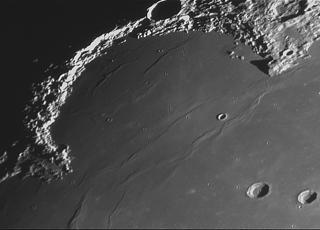
Planets
The second most accessible type of object. The planets succeed each other on a schedule, so this cycle is unlikely to bother, but, alas, they are seen much worse with amateur telescopes than with astrophotographs, not to mention photos from observatories, Hubble or interplanetary spacecraft.
Jupiter . Big, bright and beautiful planet. The telescope shows two bands on the disk and four Galilean satellites, which were the first objects discovered on the first Galileo telescope. Io, Europe, Ganymede, Callisto circle around the planet’s disk with bright dots, sometimes lining up in beautiful shapes - triangles, broken lines. In the eyepiece of the telescope, it will look something like this:
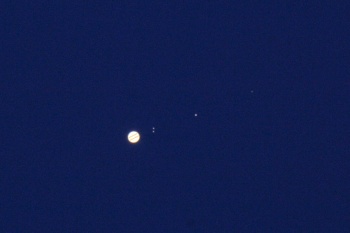
If you look closely, you can see two stripes on the disk. In this photo I had to add them, the eye has a better dynamic range than a simple amateur astrophoto.
Saturn . The next most beautiful object, its uniqueness is rings. It seems drawn into the eyepiece, but the sight is very beautiful. In a small amateur telescope, the Cassini gap is not always visible, for two years I saw it once and then not with absolute certainty.
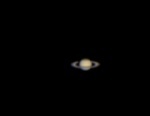
Venus . A very bright star in the morning or evening sky through a telescope is visible evenly white, but it has a unique feature - it shows the phases:
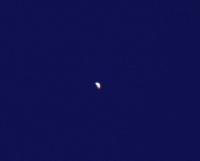
Mars . Mars is already in the zone of disappointment. In a small amateur telescope, you can only make sure that it is red:

Mercury and Uranusare far in the frustration zone. If it’s very interesting, you can find them, but there’s nothing to look at.
Multiple stars
The telescope already shows the color of the stars. And if the double star is colorful, then it is very beautiful. The most prominent representatives are Albireo in the Swan and Karl’s Heart in the Hounds of the Dogs.
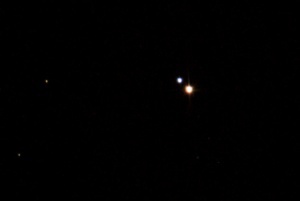
Albireo, for better color perception, you can slightly defocus the telescope.
Open clusters
Open clusters are a second type of object that is more impressive than their photographs. For the first time when he saw Chi / Ash Perseus through a telescope, a friend of mine recalled the finale of the Space Odyssey - “God! There are a lot of stars! ”
Pleiades . The eye does not see the blue nebulae that are visible on good astrophoto, but the blue tint of the stars will be distinguishable. The pleiades are so large that they fit entirely into the eyepieces with a slight increase.
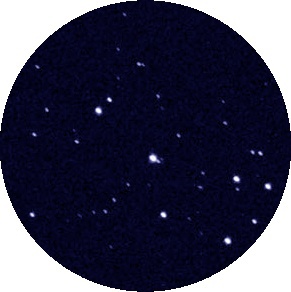
Chi / Ash Perseus
Very beautiful two open clusters nearby:
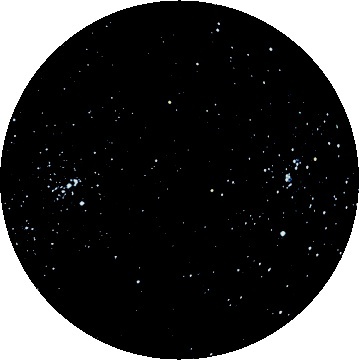
No, it's better to watch live
Globular clusters
Everything is sadder here. In an amateur telescope, globular clusters are visible as cloudy spots, but if you are lucky with the observation conditions, you can still see that they are formed by thousands and millions of stars.

A large cluster of Hercules.
Nebulae
Everything is very sad here. Due to the properties of the eye, nebulae, firstly, are black and white, secondly, they are very poorly visible, thirdly, one has to travel far out of town to dark places to see them more or less noticeable.
The Orion Nebula

M57. The “Ring” nebula in Lyre

And do not say that you do not see anything here.
The sun
Having bought a special filter, you can look at the Sun. Sun spots and granulation are visible in a regular filter (it looks like a mesh surface).

Passage of Venus on the disk of the Sun, 2012, sunspots are visible at the top.
ATTENTION: In the absence of a special filter, do not point the telescope at the Sun. It is possible to melt or even burst mounted eyepieces and irreversible blindness of the eye when trying to look through the eyepiece. The use of smoked glass, cooking foil or other substitutes instead of a special solar filter is unacceptable!
Other
If you have some luck and dexterity, you can see flying planes, the ISS (four rows of solar panels are quite distinguishable), Chinese lanterns and more.
It is also worth paying attention to the “Eyepieces” plugin, which is supplied by Stellarium. If you enter the parameters of the telescope and eyepiece, Stellarium will show the size of the object in the eyepiece.
Materiel
In order to speak objectively about telescopes, it is necessary to understand what telescopes are and what advantages and disadvantages they have.
Terms and Definitions
Aperture is the diameter of the main mirror of the telescope. In simple words, the larger the aperture, the better visible. The maximum real magnification of the telescope is two apertures. In real life, the telescope is rarely used at magnifications greater than 150-200, do not chase the increase. Also, the atmosphere is rarely good enough for telescopes with an aperture of more than 300 mm to fully express themselves.
Focal length- this is the distance at which the telescope builds an image of an infinitely distant object. Knowing the focal length is necessary to calculate the magnification of the eyepiece: magnification is the focal length of the telescope divided by the focal length of the eyepiece. For example, for a telescope with a focal length of 900 mm, a 10 mm eyepiece will give a magnification of 900/10 = 90x. Note that telescopes with short focal lengths require very short-focus eyepieces to achieve high magnifications. For example, a telescope with an aperture of 114 mm and a focal length of 500 mm will require an eyepiece of 2.5 mm for its maximum magnification. Such eyepieces are expensive and inconvenient for observation.
Relative holeIs the ratio of the aperture to the focal length. An important parameter for an astrophoto, it can be approximately compared with the aperture of the camera. For visual observations, it is important that for telescopes with a relative aperture of less than 1/6, distortions occur at the edge of the field of view of the eyepiece.
Thermostabilization . The telescope, whose temperature differs from the ambient temperature, creates additional image distortion. The shorter thermostabilization time, the better. Unfortunately, for some types it is quite large, and also, the thermal stabilization time increases with the size of the telescope.
Adjustment- the process of combining the optical axes of telescope elements. Depending on the design, it can be made at the plant for the entire period of operation, or it will have to deal with some regularity on its own.
Optical telescopes

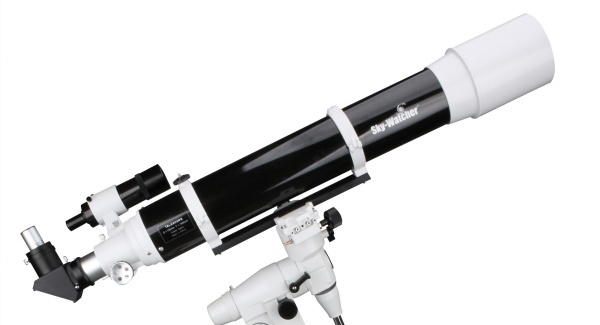
Refractor , aka telescope lens. Historically, the first type is still widespread. Modern refractors exist in two forms - achromats and apochromats. Achromats correct all image distortions (aberrations) except chromatic. They are cheap, but the objects observed in them have colored edges, which degrades the image. Apochromats also eliminate chromatic aberration, but are much more expensive.
Advantages:
- Minimum maintenance. Factory adjustment is maintained for years, the pipe is closed from dust and moisture.
- Very fast thermal stabilization.
- The aperture works fully (there are no elements blocking part of the aperture in the pipe), a higher image contrast
Disadvantages:
- Chromatic aberration for achromats, price for apochromats.
- There are no large apertures (large lenses are very difficult and expensive to make). 150 mm is already very expensive, there is practically no larger aperture.
- Long pipe (may be a drawback)


Reflector , it's a mirror telescope. It was created by Newton as a solution to the problems of the then lens telescopes. Despite the presence of other mirror schemes, it is Newton's scheme that is extremely popular now.
Advantages:
- No aberration, excellent image quality.
- The cheapest millimeter aperture - with the increase in the aperture of the reflectors more and more relative to other schemes.
- A short thermal stabilization time, which, however, increases with the size of the telescope.
Disadvantages:
- A secondary mirror with holders “eats” part of the aperture. Stretch marks of the holder give the characteristic "rays" of stars in astrophoto.
- Open pipe. Over time, the mirror becomes contaminated with dust.
- The need for adjustment. After transportation, the reflector alignment may go astray and will need to be restored. Fortunately, experience is a matter of minutes.

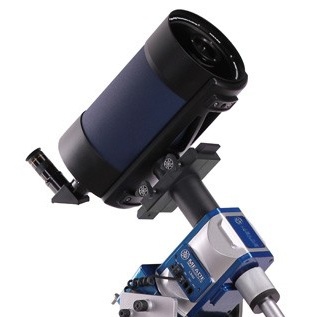
Katadiopter , aka mirror-lens telescope. They appeared in the 20th century. By the way, along with the names of Galileo and Newton, the telescope schemes immortalized the domestic astronomer Maksutov , the inventor of one of the popular schemes of mirror-lens telescopes - the Maksutov-Cassegrain scheme.
Advantages:
- Compactness. The shortest telescopes.
- A closed pipe protects the mirror from dust.
- Lack of aberration.
disadvantages
- Less contrasting image due to the central shielding zone, the aperture does not work fully.
- The most expensive millimeter aperture.
- Big time of thermal stabilization.
Mounts
A mount is an adapter between a telescope and a tripod. It depends on her how convenient it will be for you to observe, how many heavy loads to carry with you, and how much the telescope will shake during observations.
According to the basic design, the mounts are divided into alt-azimuthal and equatorial.
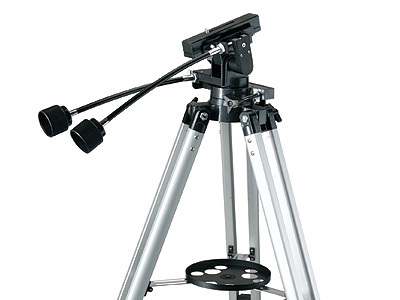
Alt-azimuth mount has two axes - azimuth and altitude, hence the name. She ignores the fact that the axis of rotation of the Earth is at an angle to the horizon.
Advantages:
- Simple, easy, load-lifting.
- No additional preparation for observations is needed.
Disadvantages:
- The object must be followed along two axes.
- The object rotates slowly in the field of view, which complicates astrophotography.
- Generally unsuitable for observing the zenith region.
The alt-azimuth Dobson mount is a little off to the side, more about it below.

Equatorial , it is also German, the mount has a third, additional axis, due to which it can be installed parallel to the axis of rotation of the Earth.
Advantages:
- The object is easy to accompany manually, even on budget mounts there is a place for mounting a simple motor, which greatly facilitates the maintenance of the object.
- No problem with the availability of zenith.
- The field of view remains motionless, which is good for astrophoto.
Disadvantages:
- The mounting is more complicated and heavy, the structure includes a very heavy counterweight.
- Mounting requires additional operations before and after observations.
The mount can also be motorized and computerized.
- In the simplest version, the equatorial mount is equipped with an analog or digital motor to accompany the object. Guidance is carried out manually.
- A more complicated option is the drives on both axes of the mount, which allow you to point the telescope at the object from the remote control (if there is a port from the laptop with the appropriate software) and accompany it automatically.
- The most difficult option is a computerized mount with its own database of objects, capable of independently aiming at the object and accompanying it. The most advanced mounts can be equipped with GPS / GLONASS and a compass for fully automatic preparation for observations.
Automation greatly simplifies life, but you need to keep in mind that this is additional money, which in case of a limited budget can be spent on a more powerful telescope.
Precautionary measures
What mistakes can be made when choosing a telescope?
Buying a telescope in a hypermarket . Now there are many specialized stores with branches in major cities and delivery in Russia. You should not take risks when buying a telescope of an unknown manufacturer with an unknown quality.
Too greedy . Refractors with an aperture of not more than 60 mm, reflectors not more than 76 mm and catadioptrics not more than 80 mm are not serious tools, as a rule, they are on very flimsy mounts, and if it is completely seams with money, it is better to dig into a normal tool or switch to binoculars.
Newtons with corrector . There are models of Newton reflectors with corrector in the focuser node. They are shorter than regular Newtons, but add distortion.
Short-focus achromat refractors. As in the previous case, they paid for image reduction in image quality. These telescopes have stronger chromatism.
Logic of choice
If you clearly represent your desires and limitations, then the choice will not be very difficult. There are a few typical scenarios to mention.
Balcony visual observations in the city
For observation on the balcony, the compactness of the telescope is important. Therefore, with a limited budget, refractors on the azimuthal mount become more preferable - with the refractor, most of the pipe will stick out, and the azimuthal mount will be easier to handle. If there is a lot of money, then you can think about catadioptrics on a motorized mount. In any case, do not chase the aperture much, 100-150 mm is enough for the city. However, such tips are advisory, I quite successfully operate an equatorial mount reflector on the balcony, because when choosing a telescope, I wanted a larger aperture without chromatism in a tight budget, and I planned to buy a drive for mounting.
Observations in the country / in the country
If there is no problem with the space under the telescope and its transportation, then, if you have a budget, you can think about a large aperture. A large aperture for a reasonable price is Newton's reflector. Also, a large aperture requires an expensive, heavy and complex classic mount. Therefore, a Dobson mount was developed, in which there is no tripod, and the telescope is mounted on a “stool” -carriage:
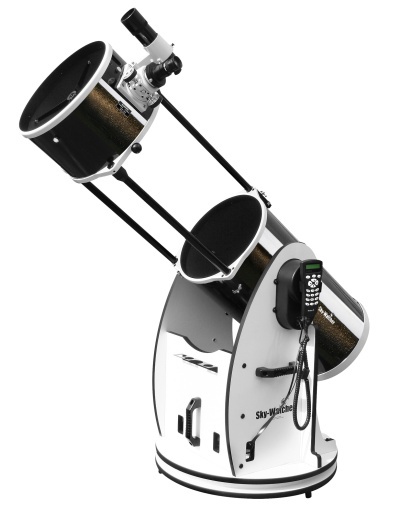
Note that the pipe is folding - this increases mobility. There are non-folding models, cheaper.
Such a design allows the production of telescopes with a very large aperture of 400 mm and higher. Such a telescope is the height of a man.
Conclusion
On Habré still wrote about leasing of telescope time , it can interest someone as an alternative. There is a site with broadcasts of interesting astronomical events , there are shown data from telescopes with comments in English.
Astrophoto is a separate big topic, with its requirements, I was not interested in it, so I did not write in addition to the most basic information.
I recommend the largest Russian Astroforum , there is a section “Advise the telescope”.
As a source for the pictures, photos were used of arm_ann , an excellent resource of RealSky and the resource “Two Archers ” .
KDPV - Astrofest 2014 .
PS Eyepieces and stuff were left overboard so that the article would not turn out too long. If there is a desire, there will be a continuation with a story about the eyepieces that I bought, etc.
